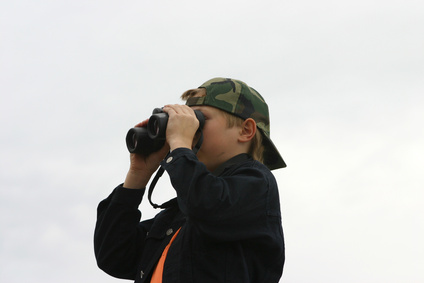If you are interested in finding, seeing, hearing and observing wildlife, then you need to increase your chances by looking in the right places! Here are some tips from this excellent book.
- First of all, define habitat. This is the place where an animal, bird, or insect lives, eats and raises young or sleeps. Kind of like your home (you eat there, sleep there, play there).
- Another thing to remember, animals, birds, insects don't always live in the same place for the whole year. Some of them migrate, others hide out while their bodies are under-going changes (like birds when moulting).
Now . . . on to the observation tips!
 |
| Geese - heading south |
- Spring - migrating species return to breed; hibernators wake up & are hungry
- Summer - time to feast and raise young
- Fall - migrators head south, over-wintering animals forage or store food
- Winter - some wildlife hole up and go on a long winter's nap; predators feed on weaker animals
 |
| American Goldfinch male |
- Day-time - early & late in the day (summer); high noon is too hot (except in winter)
- Dusk or dawn - twilight hours are usually busy times;
- DAWN: songbirds awake; night hunters get a bed-time snack & head to bed; tracks are fresh, winds still (usually), sounds carry;
- DUSK: birds twittering as they go off to sleep; night hunters start prowling; sounds carry.
- Night-time - Owls sail through the air; carnivores zigzag looking for prey; nights with a full-moon are very active; watch silhouettes of high-flying migrant flocks
HOW TO LOOK - use your eyes (of course) and also your other senses and your imagination.
- Imagine you were the animal, find out as much as you can about the animal, its habitat and survival needs.
- See the forest, not just the trees - focus on the stuff in the center, then scan the surroundings. Look at the big view, then focus on the smaller parts.
- What's wrong with this picture? Study the habitat so that you know if anything new stands out. Pay attention to the movement of leaves--then you'll be able to detect other movement.
- Use peripheral vision - notice how much MORE you can see! Animals are often threatened by a head-on stare (signals aggression).
- Extend your senses -
- EYES: binoculars, spotting scope, zoom lens on a camera;
- EARS: headphones, tape recorder;
- NOSE: perhaps you have a dog that can follow scent?
- IN THE DARK: cover flashlight with a red filter which is harder for animals to see & not notice you!
- UNDERWATER: mask, snorkle, flippers, scuba equipment
 |
| Be quiet & watch! |
GETTING WILDLIFE TO COME TO YOU
 |
| Listen & scan the branches, too! |
- Get a front row seat - sit facing an area you haven't walked through (down-wind if possible), near shrubs, with the sun at your back.
- Try to blend in - clothing (laundered in plain water--no smelly dryer sheets--dry them outside on a clothesline or hanger) to blend in with the habitat; no smelly shampoos or lotions on your hair or skin.
- Use habitat to hide you - behind a tree, downed logs, twigs in your pockets or hat brim; camoflage yourself with leaves.
- Build a blind with a view - leave it sitting for a week or two; wildlife will then ignore it once you start using it. And be patient.
- Do animal impersonations - sit comfortably, impersonate or call birds; use tape recordings, too.
- Sound an alarm - imitating an alarm call (saying "pish" with your teeth clenched, will bring curious song birds in for a closer view--especially during spring mating season) or a distress call (kiss or suck the back of your hand).
- Rattle up a buck - use deer antlers in autumn (shake them against each other, scratch in the leaf litter, and beat some bushes)--you might get a curious buck to investigate.
STALKING WILDLIFE
- Follow in their footsteps - on a dewy morning look for dry trails in grasses
- Keep the wind in your face - they won't smell you coming
- Keep the sun at your back - animals will have to squint to see you
- Play "red light, green light" to sneak up on 'em - only move in little steps and only when the animal is otherwise engaged, then freeze
- Move from hiding place to hiding place - keep vegetation between you and the animal you're observing
 |
| Shhh - don't move! |
